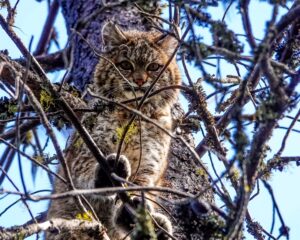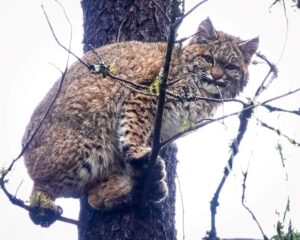While on a bit of a walkabout in Glenwood, we encountered this handsome being. Although I am not certain, my guess is that this is a female bobcat based on its size. Bobcats are moderately common, although not commonly seen, in this region. IUCN Red List categorizes them as a species of Least Concern, which is not to say that we should not respect and care for their well-being, but their populations are stable.

When it comes to life and living it, bobcats like to live in mosaic areas consisting of a variety of plant communities and seral stages (think age classes or ecosystem maturity). They are adapted to swamps, deserts, mountains and broken country. They like a lot of ledges in their home range with bog dwelling conifers being a satisfactory replacement. Depending on the region they live in, their home range size varies from about ¼ square mile (0.6 square km) all the way up to 78 square miles (202 square km); with female ranges being smaller than male’s.
Bobcats generally breed in late winter and early spring. Gestation lasts about 62 days. Adult male bobcats weigh 20 to 30 pounds and average 3 feet in length. Females are considerably smaller and may weigh less than a large house cat. They opportunistic feeders and will eat almost any prey available, including insects, fish, amphibians, reptiles, birds, and mammals. They are mostly crepuscular in habit i.e. most active at dawn and dusk. Similar to cougars, a bobcat will cover the remains of a large kill with debris such as snow, grass, or leaves and will revisit a carcass until most of it is consumed.

When it comes to management and fire, bobcats can deal with moderate human activity and can benefit from timber management and prescribed fire that helps create or maintain mosaic patterns on the landscape. Both activities can improve foraging habitat and the prey base of bobcats provided they maintain key habitat structures such as cover around ledges, riparian zones, and ridgelines. Small gaps created through fire or mechanical means and delaying canopy cover can promote prey species for bobcats. Habitat diversity is an important element for our bobcat friends.
P.S. If you would like to have a job where there is potential to see bobcats and a variety of other super cool natural stuff. Apply for our Natural Resource Technician (Monitoring) position!! Details can be found on our website: https://mtadamsstewards.org/employment/.
Resources:
IUCN Red List. https://www.iucnredlist.org/
Fire Effects Information System. https://www.feis-crs.org/feis/
WA Dept. of Fish & Wildlife. https://wdfw.wa.gov/
Photos by David Ryan, Mt. Adams Resource Stewards: Monitoring & Outreach Coordinator.
